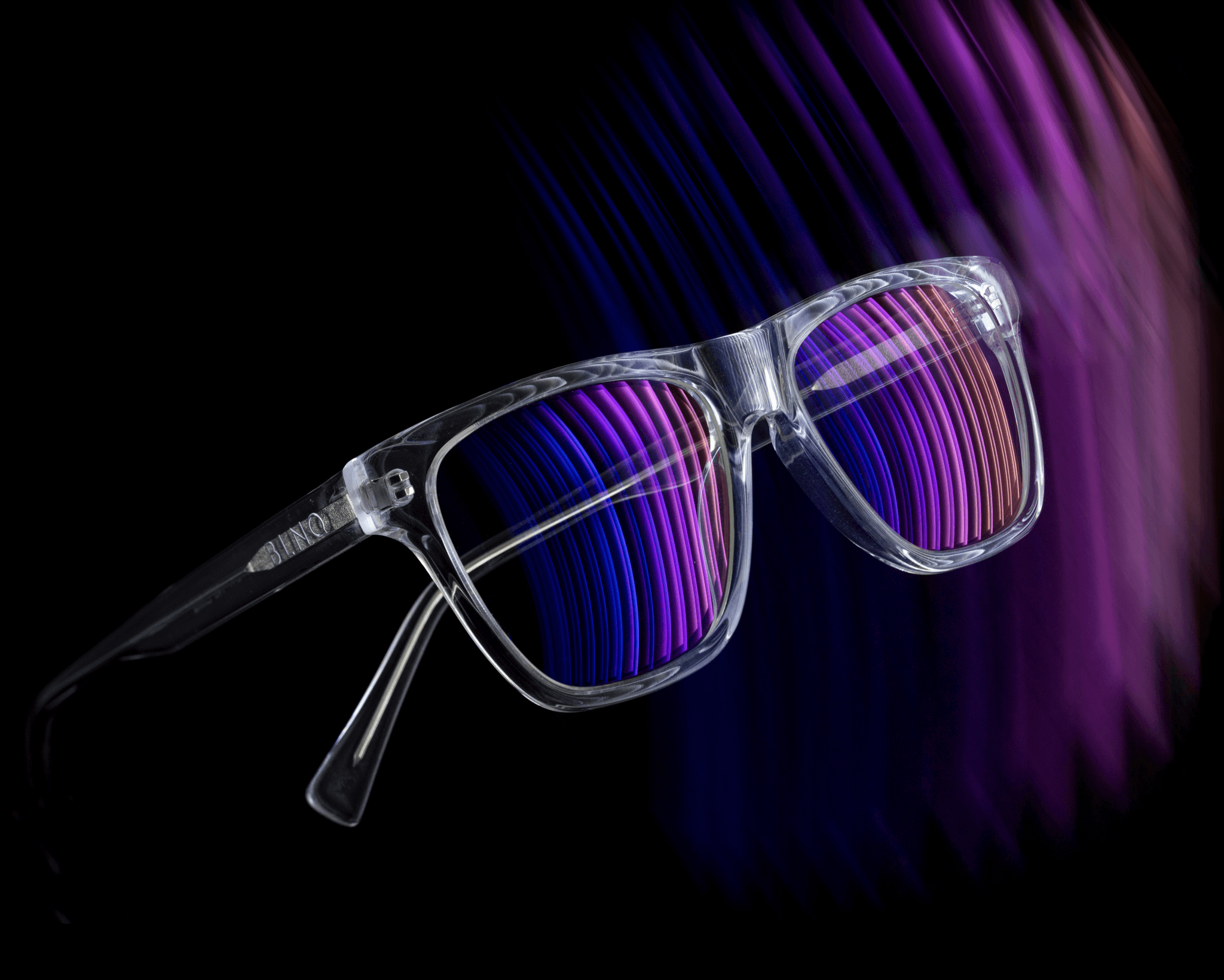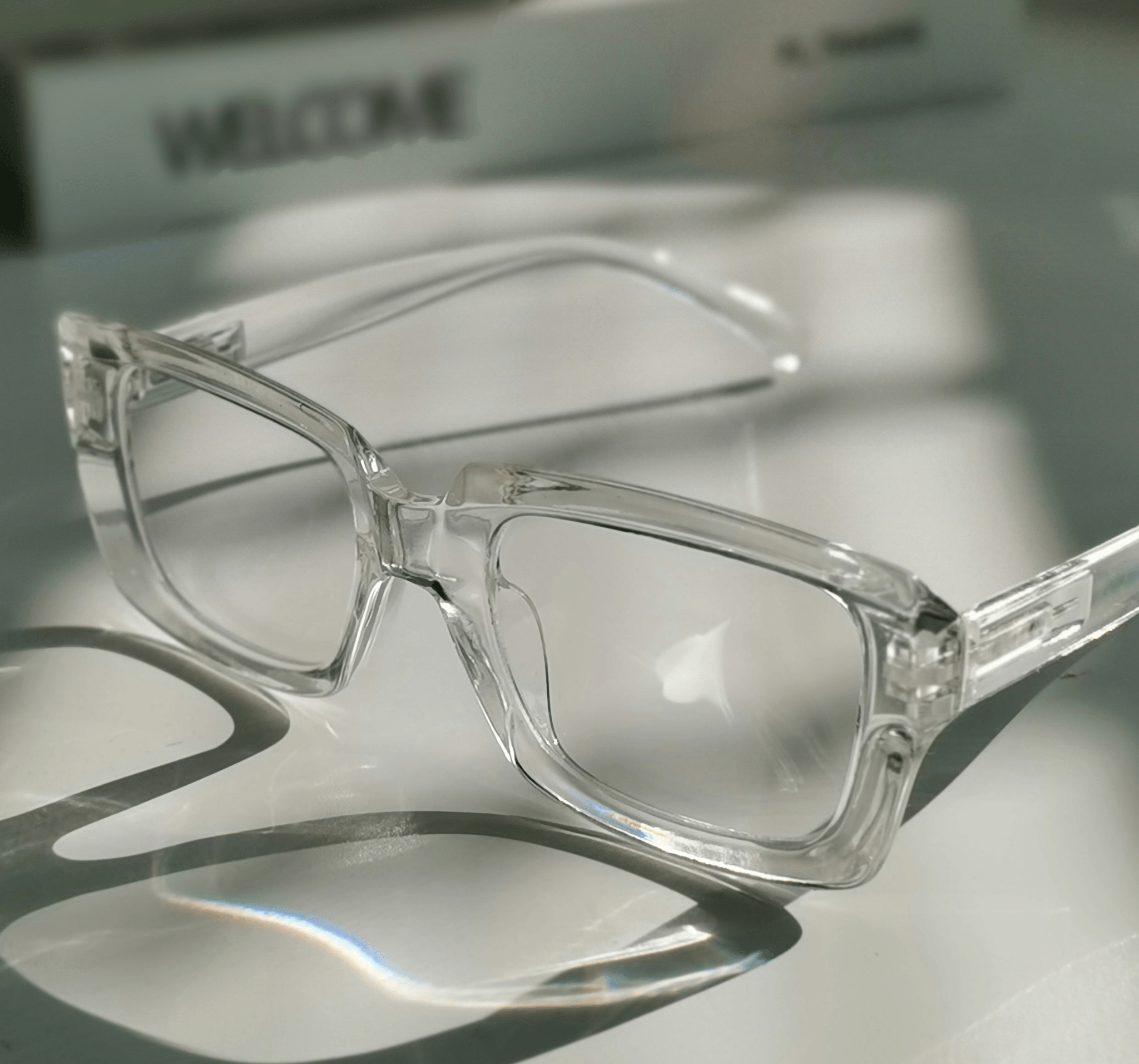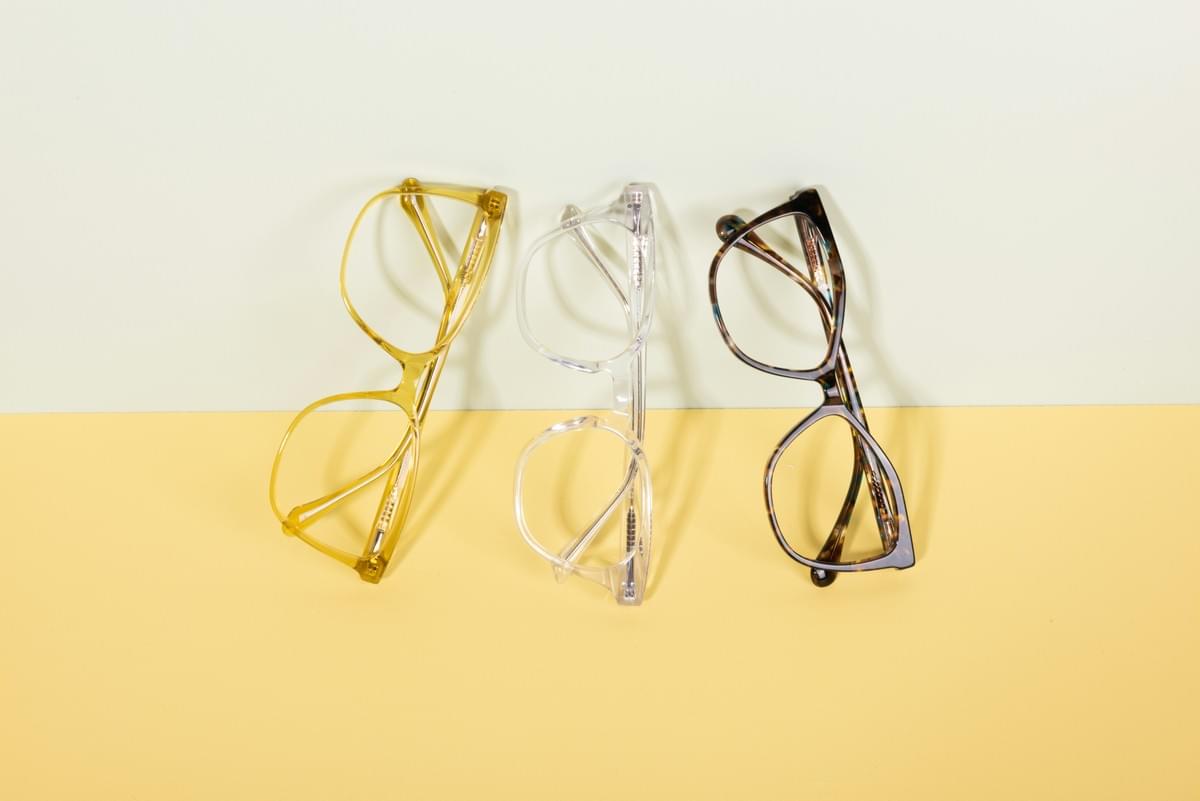Introduction

The materials used in lens construction can significantly impact your vision, comfort, and overall experience while wearing sunglasses. In this guide, we’ll delve into the science behind sunglasses lenses and explore how different materials affect your visual clarity and protection.
Understanding Eyewear Lens Materials
Sunglasses lenses are crafted from various materials, each with its own set of advantages and disadvantages. Whether you’re curious about how to identify if your lenses are polycarbonate or plastic or pondering which sunglass lens material is best for your needs, this section will provide clarity. From traditional glass to modern plastics, each material plays a unique role in enhancing your eyewear experience.
The Science Behind Sunglasses Lenses
The science behind sunglasses lenses is fascinating and multifaceted; it’s not just about looking stylish under the sun! Different lens materials offer varying levels of UV protection, optical clarity, and durability—key factors that influence how well you see outdoors. Additionally, understanding what Ray-Ban sunglass lenses are made of can help you appreciate their quality craftsmanship while ensuring that you're equipped with the right features for your lifestyle.
The Impact of Lens Materials on Vision
The impact of lens materials on vision cannot be overstated; they can enhance or hinder your visual experience depending on their properties. For instance, polarized lenses—often found in both glass and plastic formats—are designed to reduce glare but vary in performance based on their construction material. So whether you're asking yourself if polarized lenses are glass or plastic or simply want to know more about the benefits they offer, it's essential to consider how these factors play into your choice of eyewear.
Common Lens Materials Explained

Understanding what are sunglasses lenses made of is essential for making informed choices about eye protection and comfort. In this section, we will explore three common lens materials: glass, plastic, and polycarbonate.
Glass: The Traditional Choice
Glass has long been regarded as the traditional choice for sunglass lenses, offering a classic aesthetic that many still prefer today. One of the standout features of glass is its superior optical clarity; it provides a distortion-free view that enhances visual experience, making it ideal for those who prioritize precision in their eyewear. However, while glass lenses offer durability and scratch resistance, they can be heavier than other options—something to consider if you're wondering which sunglass lens material is best for all-day wear.
Plastic: Lightweight and Durable
Plastic lenses have gained immense popularity due to their lightweight nature and affordability. If you're asking yourself how do I know if my lenses are polycarbonate or plastic?, a quick examination will reveal that plastic tends to feel lighter and may also be less expensive than its counterparts. These lenses come in various styles, making them versatile enough for both prescription needs and fashion-forward designs—perfect for anyone looking to balance style with practicality.
Polycarbonate: Impact-Resistant Wonder
Polycarbonate lenses have emerged as the safety heroes of eyewear materials, especially favored by active individuals or parents shopping for children’s eyewear. Known for their remarkable impact resistance, these lenses are less likely to shatter upon impact compared to glass or standard plastic options—making them an excellent choice if you lead an adventurous lifestyle or want peace of mind when your kids play outside. Additionally, many brands like Ray-Ban offer polarized versions made from polycarbonate; so if you’re pondering whether polarized lenses are glass or plastic, rest assured they can often be found in this durable material.
Benefits of Glass Lenses

From superior optical clarity to impressive durability, these lenses offer a unique combination that appeals to both fashion-conscious individuals and those who prioritize functionality. Let’s dive into the benefits of glass lenses and see why they might just be the best option for your sunglasses.
Superior Optical Clarity
One of the standout features of glass lenses is their exceptional optical clarity. If you’ve ever wondered, Which sunglass lens material is best? glass often takes the crown due to its minimal distortion and high light transmission. This means that when you wear sunglasses with glass lenses, you can expect crisp and clear vision—perfect for enjoying sunny days without squinting.
Scratch Resistance and Durability
Another compelling benefit of glass lenses is their natural scratch resistance. Unlike plastic or polycarbonate options, which can easily scratch over time, glass maintains its integrity even after years of use. So if you're asking yourself, How do I know if my lenses are polycarbonate or plastic? just remember that if they look like they've been through a battle but still shine bright, they're likely made from durable glass.
Aesthetic Appeal in Eyewear
Let’s not forget the aesthetic charm that glass lenses bring to eyewear design! Many brands like Ray-Ban opt for high-quality glass in their iconic styles because it adds a touch of sophistication and elegance. If you've ever wondered what are sunglasses lenses made of in those classic designs, chances are it's premium-grade glass that enhances both style and functionality.
Advantages of Plastic Lenses

Lightweight Comfort for All-Day Wear
One of the standout features of plastic lenses is their lightweight nature. Unlike glass lenses, which can feel heavy on the nose after prolonged use, plastic options allow for all-day wear without discomfort. This makes them particularly appealing for those who ask, How do I know if my lenses are polycarbonate or plastic? Typically, if your sunglasses feel feather-light yet sturdy, they’re likely made from a type of plastic.
Affordable Option for Various Styles
When considering eyewear choices, budget often plays a crucial role in decision-making. Plastic lenses emerge as an affordable option for various styles without compromising quality or aesthetics. Whether you’re looking for trendy frames or classic designs like Ray-Ban sunglass lenses—many of which utilize high-quality plastics—you can find something that fits your wallet and your face.
Versatility in Prescription and Fashion
Plastic lenses are not just limited to fashion; they also excel in prescription eyewear applications. Their versatility allows them to be crafted into different shapes and sizes while accommodating various prescriptions seamlessly. So when pondering which sunglass lens material is best? Look no further than plastic; it harmonizes style with function effortlessly.
Polycarbonate Lenses: The Safety Heroes

These lenses are made from a thermoplastic material that is both lightweight and incredibly impact-resistant, making them perfect for sports enthusiasts and adventurers alike. If you’re wondering, “What are sunglasses lenses made of?” polycarbonate is definitely a material worth considering for its robustness and versatility.
Ideal for Active Lifestyles
Polycarbonate lenses are ideal for active lifestyles due to their remarkable strength and flexibility. Whether you're biking down a rugged trail or engaging in water sports, these lenses can withstand the rigors of outdoor activities without shattering or cracking easily. Plus, their lightweight nature ensures that you can wear them comfortably all day long without feeling weighed down.
If you're curious about how to determine if your lenses are polycarbonate or plastic, look for markings on the lens or check with the retailer where you purchased them. Many brands proudly advertise polycarbonate as a feature due to its safety benefits. In fact, if you’re asking yourself which sunglass lens material is best for protection during high-energy activities, polycarbonate often takes the crown.
UV Protection and Safety Features
One of the standout features of polycarbonate lenses is their built-in UV protection that shields your eyes from harmful sun rays. This aspect makes them an excellent choice not just for style but also for health—keeping your vision safe while enjoying outdoor adventures under the sun’s glare. Additionally, many manufacturers enhance these safety features with scratch-resistant coatings, ensuring your sunglasses remain clear and functional over time.
If you've ever wondered what Ray-Ban sunglass lenses are made of, it's worth noting that they offer various options including glass and plastic; however, some models do feature durable polycarbonate materials designed specifically for active users seeking both style and safety in their eyewear choices. This combination makes polycarbonate an attractive option when considering how well sunglasses protect against environmental hazards while still looking chic.
Popularity in Children’s Eyewear
Polycarbonate lenses have gained immense popularity in children’s eyewear because they provide essential protection without compromising comfort or style. Kids are naturally prone to roughhousing and playtime mishaps; thus, having glasses made from a material that won't easily shatter is crucial for peace of mind among parents. Not only do these lenses offer durability but they also come equipped with UV protection—perfectly suited to shield young eyes during outdoor adventures.
When selecting eyewear options for children, it’s important to ask retailers about lens materials so you can confidently choose between plastic or polycarbonate based on safety needs—especially if you want something that can withstand frequent use without breaking down quickly! If you're still unsure which sunglass lens material is best suited for kids' active lives, remember: polycarbonate provides an unbeatable blend of safety features tailored specifically toward younger users.
Specialty Lens Materials

Whether you’re looking for high-index lenses for a strong prescription, photochromic lenses that adapt to light, or anti-reflective coatings for enhanced vision, each option provides distinct advantages. Understanding these materials can help you make an informed decision about what are sunglasses lenses made of and how they can improve your visual experience.
High-Index Lenses for Strong Prescriptions
High-index lenses are designed specifically for those with strong prescriptions, offering thinner and lighter options compared to traditional lenses. If you find yourself asking, How do I know if my lenses are polycarbonate or plastic? the answer is simple: high-index lenses often have a distinct feel and appearance due to their advanced materials that reduce bulkiness. Not only do they enhance comfort by minimizing weight, but they also provide superior optical clarity—perfect for those who need corrective eyewear without the extra thickness.
Photochromic Lenses: Adapting to Light
Photochromic lenses are like chameleons; they adapt based on the light conditions around you. These innovative sunglasses lenses darken in bright sunlight and return to clear indoors, making them incredibly convenient for those on the go. If you're wondering which sunglass lens material is best for versatility and convenience, photochromic options stand out as an excellent choice—ideal for anyone who frequently transitions between indoor and outdoor environments.
Anti-Reflective Coatings for Enhanced Vision
Anti-reflective coatings take your eyewear game up a notch by reducing glare from screens and lights, which can be particularly beneficial during long hours of use. When considering whether polarized lenses are glass or plastic, it's essential to note that many polarized options come with anti-reflective coatings as well—providing both protection from harmful UV rays while enhancing visual clarity. This combination not only improves comfort but also elevates your overall viewing experience; perfect if you're someone who spends time outdoors or in front of digital devices.
Conclusion
Choosing the right sunglasses lens material can feel like navigating a labyrinth of options, but it ultimately comes down to balancing functionality and style. Whether you're looking for superior optical clarity, lightweight comfort, or impact resistance, understanding what are sunglasses lenses made of is crucial. With the right information in hand, you can confidently select a pair that complements your lifestyle while enhancing your vision.
Balancing Functionality and Style
Many people wonder which sunglass lens material is best for their needs; this often depends on personal preferences and lifestyle choices. While glass lenses offer unparalleled clarity and scratch resistance, plastic lenses provide lightweight comfort and affordability—it's all about finding what works for you.
Choosing the Right Lens for Your Needs
If you're asking yourself how do I know if my lenses are polycarbonate or plastic?, look for specific markings or ask your optician during your next visit. Polycarbonate lenses are known for their impact resistance, making them ideal for active lifestyles—perfect if you’re always on the go! Ultimately, understanding the benefits of each lens type will help you make an informed choice that meets both your visual requirements and aesthetic desires.
Aisen Optical: Custom Solutions for Every Brand
At Aisen Optical, we recognize that every brand has unique needs when it comes to eyewear solutions. Whether you're interested in Ray-Ban sunglass lenses made from high-quality glass or exploring polarized options available in plastic materials, we've got you covered. Our custom solutions ensure that no matter what are sunglasses lenses made of, you'll find the perfect fit tailored just for you!
